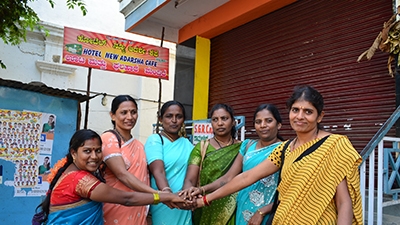November 28, 2012 – Sex worker Akram Pasha remembers when his hometown of Mysore, India—an idyllic southern tourist hub known for a Maharajah’s palace and its many universities—stood on the brink of an explosive epidemic.
In 2004, a new community-based organization in the city, called Ashodaya Samithi, conducted a first-ever survey of local sex workers and found an HIV prevalence of 25%.
“We were shocked,” said Pasha, who now serves as director of Ashodaya Academy, which trains sex workers in HIV prevention, leadership and community mobilization. “It could have been any one of us. We knew we had to do something to protect that 25% and prevent it from spreading to the other 75%.”
At the time, Mysore had no HIV prevention programs in place, and there was only one HIV testing and counseling center at the district hospital. Services simply weren’t reaching those who needed them most.
“There wasn’t a condom to be seen,” said Dr. Sushena Reza-Paul, an assistant professor of public health with the University of Manitoba, who helped start Ashodaya Samithi. “I remember walking several kilometers before finding one medical shop with a handful of condoms, and they were all expired.”
‘By the Community’
Today, India has averted at least 3 million HIV infections in large part through empowering key populations at highest risk -- including sex workers, men who have sex with men, people who inject drugs and migrants -- to take control of the epidemic through providing counseling, care, support and treatment to their peers, and advocating for their own needs. Some programs targeted to sex workers also provide training for alternative income-generating activities, such as tailoring, with the aim of reducing exposure to HIV.
Ashodaya Samithi is one example of this community ownership approach, which was significantly scaled up—with the help of community-based and nongovernmental organizations —during phase III of India’s National AIDS Control Program (NACP III), from 2007 to 2012. The World Bank has worked closely with the Indian government to develop a national response to HIV and AIDS that emphasizes targeted interventions for those most at risk.
Led by its 8000-plus female, male and transgender sex worker members, Ashodaya Samithi has played a critical role in reversing the epidemic in southern Karnataka state, one of four high-prevalence states that account for 55% of all HIV infections in India. Its members promote condom use, provide HIV testing and counseling, link HIV-positive sex workers to antiretroviral therapy centers so they can receive treatment, and volunteer in hospitals to ensure fellow sex workers receive adequate services and aren’t discriminated against.
To expand its services, the group has taken a social enterprise approach; it runs a local restaurant, originally funded by a World Bank Development Marketplace grant, as well as serviced apartments. Profits go to support a community care home for HIV-positive sex workers.
Attacking the epidemic on all fronts has paid off: A 2009 survey (the latest available) found HIV prevalence among all sex workers in five districts around Mysore to be 11.1%, down from 25% in 2004. Condom use with sex worker respondents’ last client was 93.8%, up from 64.8% in 2004.
A national HIV Sentinel Survey from 2010-2011 found HIV prevalence among sex workers across Karnataka state to be 5.35%.
“We’ve provided long-term access to services, reduced stigma and created an enabling environment, so that the increased utilization of HIV services we’ve seen does not get undermined,” said Prathima Ramaya, an HIV-positive sex worker and Ashodaya Samithi manager.
The group has been so successful at building capacity to provide HIV and AIDS-related services, it’s now training sex worker groups from other countries, including Nepal, Bangladesh, Myanmar and Mozambique.
“It was a bottom-up process” said Dr. Reza-Paul, referring to the group’s early mobilization to address the HIV epidemic. “We’ve moved from being ‘for’ the community, to being ‘by’ the community.”
Rights-Affirming Approach
India is home to 2.4 million people living with HIV, with national adult prevalence at 0.31%. Among groups at high risk of HIV infection, 2010 data show national prevalence at 2.61% for female sex workers, 5.01% for men who have sex with men; 5.91% for injecting drug users and 18.0% for transgenders. As with Karnataka state, some regions report much higher prevalences.
By keeping key populations at higher risk at the center of designing and leading HIV and AIDS programs, India’s NACP has achieved 80% coverage of services in these populations. Phase IV of the program, launched earlier this year, will continue to scale up services and community engagement with these groups to prevent new HIV infections.
A new World Bank report, The Global HIV Epidemics Among Sex Workers, undertaken in partnership with the Johns Hopkins Bloomberg School of Public Health and the United Nations Population Fund (UNFPA), confirms that a targeted approach can significantly curb progression of the epidemic. Mathematical models developed for the report show that expansion of community empowerment-based, comprehensive HIV prevention among sex workers demonstrates significant impact on HIV among sex workers as well as in the general population, across different settings and epidemic scenarios.
“We found that interventions targeted to sex workers are cost-effective and provide significant return on investment,” said Robert Oelrichs, World Bank senior health specialist and one of the report’s authors. “Those that are rights-affirming and community-empowering are most successful. AIDS spending decisions should reflect this.”
India’s experience bears this out: A 2011 Bank impact evaluation found a significant decline in HIV prevalence among female sex workers in four high-prevalence southern states where the number of HIV interventions tailored to them had increased dramatically -- from 5 to 310 between 1995 and 2008.
“The Bank will continue to provide support for India’s NACP Phase IV, through US$255 million in financing, analytical work and sharing of India’s best practices in HIV and AIDS prevention, care, support and treatment across the world.” said Sameh El-Saharty, World Bank senior health specialist and project team leader.


